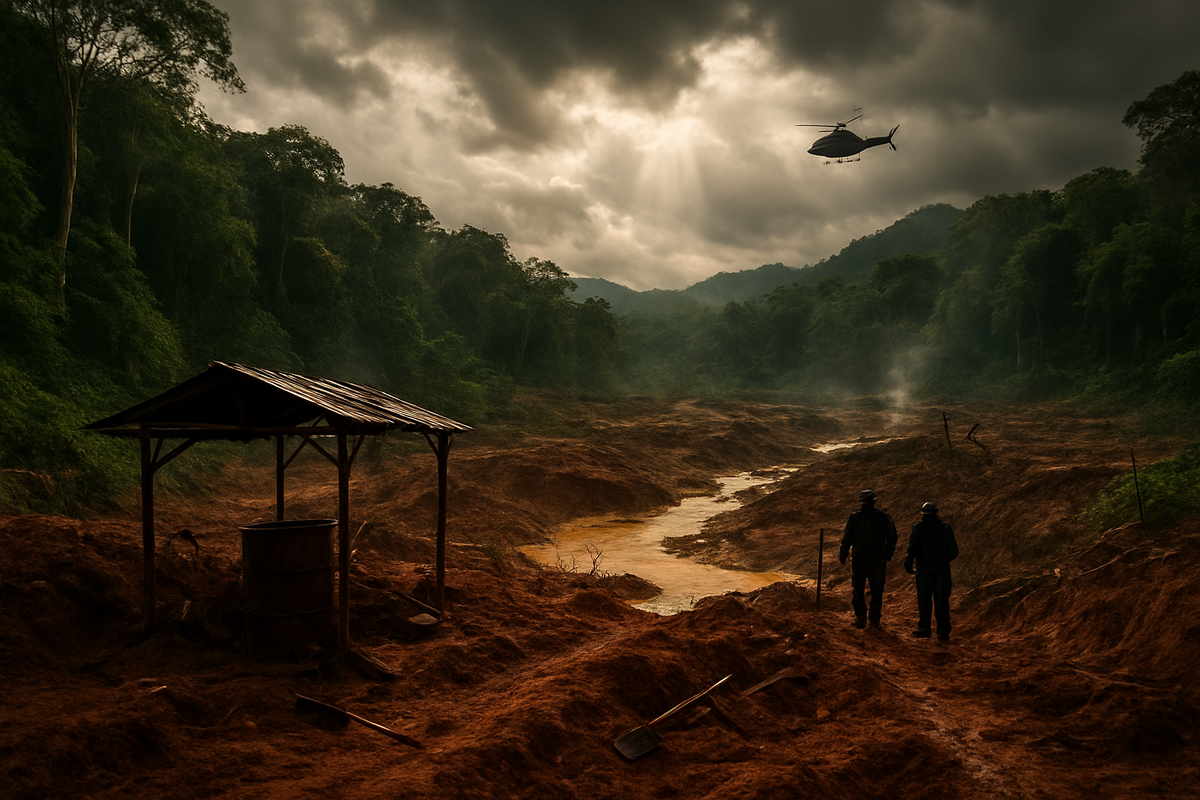Costa Rica's Gold Standard Under Threat: Intensified Crackdown on Illegal Mining in Crucitas Sparks Market Reassessment

San José, Costa Rica – October 27, 2025 – Costa Rica, a nation globally lauded for its pristine natural beauty and unwavering commitment to environmental conservation, finds itself at a critical crossroads. Today, law enforcement escalated its fight against rampant illegal gold mining in the environmentally sensitive Crucitas region, near the Nicaraguan border. This intensified crackdown, marked by large-scale operations dismantling illicit camps and arresting numerous individuals, underscores the nation's struggle to protect its natural resources from the clutches of organized crime and the allure of high gold prices. The immediate implications are clear: a desperate bid to reclaim sovereignty over its land, mitigate severe ecological damage, and potentially reshape the future of gold extraction in a country that has historically shunned large-scale mining.
The government's decisive action today in Crucitas is a stark reminder of the persistent challenges posed by illicit resource exploitation. While aimed at preserving Costa Rica's "green" image, these efforts also ignite complex discussions about national security, economic development, and the potential re-evaluation of long-standing mining prohibitions, sending ripples through both local communities and the broader financial markets.
A Golden Rush in the Green Heart: The Battle for Crucitas
The fight against illegal gold mining in Crucitas is a saga rooted in a tumultuous past. The region became a hotspot for illicit extraction following the definitive cancellation of a legal open-pit gold mining project by Canadian company Infinito Gold (TSX.V:IG, OTCPINK:IGFFF) in 2010. This landmark decision by Costa Rica's courts, driven by environmental concerns and irregularities in the permitting process, inadvertently created a vacuum that thousands of informal miners, or "coligalleros," many from Nicaragua, quickly filled. These operations, initially artisanal, have since evolved into semi-industrial enterprises often controlled by organized crime, employing destructive methods involving mercury and cyanide that severely contaminate local ecosystems and water sources.
Today's operation saw Costa Rican authorities dismantle nine illegal mining camps and arrest thirteen Nicaraguan nationals with irregular immigration status. Seized items included mining equipment, firearms, marijuana, and Nicaraguan currency, highlighting the nexus between illegal mining and broader criminal activities. The Ministry of Public Security, coordinating air and ground patrols with the Border Police, noted the detection of extracted earth being transported across the border to Nicaragua for sale, a clear indication of a sophisticated smuggling network incentivized by surging international gold prices. This crackdown is part of a sustained effort; police have maintained permanent patrols in Crucitas since 2018, with significant operations in March 2023 leading to a state of emergency declaration due to severe mercury contamination of drinking water. The ongoing crisis has seen the National Institute of Aqueducts and Sewers providing potable water via tanks to affected areas, underscoring the profound human and environmental toll.
The timeline of events leading to this moment is crucial. After the 2010 ban, Infinito Gold (TSX.V:IG, OTCPINK:IGFFF) sought nearly $400 million in damages from the Costa Rican state through international arbitration, a claim that was ultimately denied in July 2024. Following this victory, President Rodrigo Chaves signaled a potential shift, indicating that open-pit mining was being considered for Crucitas. By late November 2024, President Chaves submitted Bill 24,777 to the national assembly, proposing an exception to the 14-year ban for Crucitas, allowing regulated extraction with a minimum 5% royalty to the state. Most recently, in September 2025, the Legislative Assembly's Alajuela Commission approved draft legislation (24.717) to allow gold extraction in Crucitas, strictly prohibiting open-pit mining using cyanide and mercury and mandating closed-cycle methods. These legislative movements, occurring just weeks before today's intensified crackdown, suggest a dual strategy: aggressive enforcement against illegal operations coupled with a push for a controlled, legal framework for the area's estimated 1.2 million ounces of gold.
Key players in this ongoing drama include various Costa Rican government agencies such as the Ministry of Environment and Energy (MINAE), the Ministry of Public Security, and the Legislative Assembly, all grappling with policy and enforcement. Environmental groups like Friends of the Earth Costa Rica and AIDA (Interamerican Association for Environmental Defense) have consistently advocated against large-scale mining and for environmental protection. On the corporate side, Infinito Gold (TSX.V:IG, OTCPINK:IGFFF) remains a historical key player, though its legal battle concluded. Local communities, including "coligalleros" and residents affected by contamination, are also central stakeholders. Initial market reactions to the cancellation of Infinito Gold's project were strong, leading to the company's arbitration claim and, paradoxically, the "gold rush" of illegal miners, who have exported an estimated $152 million in untaxed gold bullion between 2017 and 2024, demonstrating the immense profitability of illicit extraction.
Corporate Stakes: Winners and Losers in the Crucitas Crucible
The intensified crackdown on illegal gold mining in Crucitas, while primarily targeting illicit actors, has significant indirect implications for public companies across the gold industry. The most directly impacted public entity remains Infinito Gold (TSX.V:IG, OTCPINK:IGFFF). Having invested $92 million and projecting $1 billion in lost profits from its cancelled Crucitas concession, the company's market position has been severely diminished, with its stock trading at negligible valuations. The recent arbitration ruling in favor of Costa Rica further cemented this negative impact, effectively closing the chapter on Infinito Gold's direct involvement in Crucitas. The current crackdown, therefore, does not directly affect Infinito Gold's operations, as they no longer hold legal rights to the deposit.
For legally operating gold mining companies globally, such as Newmont Corporation (NYSE:NEM), Barrick Gold Corporation (NYSE:GOLD), Kinross Gold Corporation (NYSE:KGC), Agnico Eagle Mines Limited (NYSE:AEM), Torex Gold Resources Inc. (TSX:TXG), and Equinox Gold (TSX:EQX, NYSE:EQX), the situation in Crucitas presents a nuanced picture. While none currently have legal operations in Costa Rica, a successful reduction in illegal gold supply can indirectly benefit them. Illicit gold, often produced at lower costs due to a disregard for environmental and labor regulations, can depress global prices or create unfair competition. A cleaner global supply chain, driven by crackdowns like Costa Rica's, aligns with the growing emphasis on responsible sourcing and Environmental, Social, and Governance (ESG) practices. Companies with strong ESG credentials may see enhanced investor confidence and a stronger market position as the industry faces increasing scrutiny over ethical gold provenance.
Gold trading and refining companies, particularly those committed to responsible sourcing initiatives like the Responsible Minerals Assurance Process (RMAP), face both opportunities and risks. For legitimate players, the crackdown simplifies due diligence processes by reducing the volume of illicit gold available, thereby lowering the risk of inadvertently acquiring tainted gold. This reinforces the value of responsibly produced gold and strengthens ethical supply chains. However, for any company—public or private, including refiners, traders, or even downstream users in electronics or jewelry—that has knowingly or unknowingly processed laundered illegal gold from Crucitas, the risks are substantial. Exposure of links to illicit gold can lead to severe reputational damage, significant legal and financial penalties under regulations like the EU Conflict Minerals Regulation, and disruptive supply chain adjustments as companies are forced to seek new, verifiable legal sources. The ongoing efforts in Costa Rica highlight the critical need for robust traceability and transparency throughout the global gold supply chain, impacting any entity that fails to uphold these standards.
Beyond Borders: The Wider Significance of Costa Rica's Stand
Costa Rica's intensified fight against illegal gold mining in Crucitas transcends its national borders, resonating deeply with broader industry trends in ethical sourcing, environmental regulations, and the global struggle against organized crime. The nation's initial 2010 ban on open-pit mining set a significant precedent, positioning it as an environmental vanguard and inspiring similar environmental activism across Latin America. However, the subsequent emergence of rampant illegal mining in Crucitas exposed a critical vulnerability: the difficulty of enforcing environmental protection in resource-rich areas where economic desperation and criminal enterprises converge.
This ongoing battle in Crucitas underscores the persistent global challenge of Artisanal and Small-Scale Mining (ASM). Accounting for roughly 20% of global gold production, ASM is often plagued by unsafe labor conditions, child labor, and severe environmental damage from unregulated mercury and cyanide use—issues acutely visible in Crucitas. The Costa Rican government's efforts, including its National Action Plan under the Minamata Convention to reduce and eliminate mercury use in ASGM, align with global pushes for greater formalization and responsible practices within this sector. The situation in Crucitas serves as a stark contrast to the anticipated universal adoption of real-time monitoring, blockchain reporting, and AI-powered compliance tools expected in 2025 to enhance transparency and traceability in the formal mining sector.
The ripple effects of Costa Rica's actions are manifold. Other gold-producing nations, particularly those with prevalent ASM sectors in Latin America and Africa, could face increased international scrutiny regarding the provenance and environmental impact of their gold. Companies committed to responsible sourcing may intensify their due diligence, potentially impacting trade relationships with regions struggling with illicit mining. Furthermore, the cross-border movement of miners from Nicaragua, influenced by mining concessions granted by the Nicaraguan government near the border, illustrates the transnational nature of these challenges and the need for greater international cooperation in combating illegal trade and the smuggling of hazardous chemicals like mercury. Costa Rica's legislative efforts to increase penalties for environmental crimes committed by organized groups could also serve as a model for other countries confronting similar issues. Historically, the challenges faced in Crucitas mirror those seen in other Latin American nations where environmental activism clashes with extractive industries, and globally, where governments struggle to police remote areas offering the lure of quick income from illegal resource extraction.
What Comes Next: Navigating the Golden Path Ahead
The coming months will be pivotal for Costa Rica's gold mining sector, as the nation grapples with both the immediate aftermath of today's crackdown and the long-term implications of proposed legislative changes. In the short term, expect a sustained and potentially intensified government presence in Crucitas, with continued police operations aimed at disrupting illegal mining camps and smuggling routes. Environmental remediation efforts will likely gain urgency, focusing on assessing and mitigating the severe mercury contamination that has plagued the region. Critically, the Legislative Assembly will engage in intense debate over President Chaves' administration's bill to re-legalize large-scale open-pit gold mining specifically for the Crucitas deposit. The outcome of this legislative process will largely dictate the direction of Costa Rica's gold sector for decades to come.
In the long term, if the proposed legislation passes, it would mark a significant policy pivot, potentially opening Crucitas to regulated gold extraction by national or international companies. This could generate substantial royalties for the state, earmarked for local development and environmental restoration. However, any legal mining company operating in Costa Rica would face unprecedented scrutiny, requiring strict adherence to international best practices for environmental protection, a guarantee of environmental restoration, and robust community engagement to secure a social license to operate. Conversely, if the legislative efforts fail, illegal mining will likely persist, continuing to inflict environmental damage and feed illicit markets, with the government losing potential tax revenues and struggling to formalize the existing artisanal sector. A hybrid approach, focusing on enhanced support for formalized artisanal and small-scale mining with mercury-free extraction methods, could also emerge as a more environmentally palatable alternative.
Market opportunities could arise from the estimated 1.2 million ounces of untapped gold reserves in Crucitas, especially with strong international gold prices making legal ventures more attractive. For companies committed to ethical sourcing, operating under Costa Rica's stringent environmental and social standards could open doors to niche markets demanding "conflict-free" or responsibly produced gold. However, significant challenges loom. Costa Rica's global reputation as an environmental leader is at stake, and any perceived failure to manage mining responsibly could severely impact its crucial ecotourism industry. Strong opposition from environmental groups and the entrenched presence of organized crime in illegal mining pose ongoing security and operational risks, demanding robust due diligence from potential investors. The historical volatility of policy reversals also creates regulatory uncertainty, which can deter foreign investment. The decision on Crucitas will profoundly influence whether Costa Rica can harness its mineral wealth for national development while upholding its renowned environmental principles, with high stakes for both economic gains and the preservation of its ecological heritage.
A Golden Future: Balancing Prosperity and Preservation
The events unfolding in Crucitas represent a microcosm of the complex global challenges inherent in resource extraction, sustainable development, and environmental governance. Costa Rica's intensified fight against illegal gold mining and its ongoing legislative debate highlight a pivotal moment for a nation long celebrated for its "green" identity. The key takeaway is the profound tension between economic opportunity and environmental preservation, a balance that Costa Rica is now actively, and sometimes painfully, seeking to strike. The market is moving forward with a keen eye on legislative developments and the effectiveness of enforcement actions.
The lasting impact of this period will depend on the government's ability to implement a coherent and sustainable strategy. Should the proposed re-legalization of mining in Crucitas proceed, its success will hinge on strict adherence to international environmental standards, transparent concession processes, effective revenue utilization for local communities and environmental remediation, and the decisive displacement of illegal operations. Failure to do so could not only exacerbate environmental degradation but also tarnish Costa Rica's carefully cultivated global image and potentially impact its thriving ecotourism sector. Conversely, a successful model could set a new benchmark for responsible resource development in environmentally sensitive regions.
Investors eyeing Costa Rica's gold sector, or the broader gold market, should remain highly vigilant in the coming months. The passage or rejection of Bill 24,777 in the Legislative Assembly is the most critical immediate factor. Beyond that, a deep assessment of regulatory and ESG risks is paramount; prioritize companies with proven track records in environmental stewardship, advanced extraction technologies, and robust social responsibility programs. Understand the political and social sensitivities surrounding mining in Costa Rica, and factor in the persistent challenges posed by illegal mining and organized crime. While global gold prices will always influence market dynamics, the unique local context of Costa Rica demands an extra layer of due diligence and a long-term perspective focused on sustainability and ethical practices. The future of gold in Costa Rica is not just about ounces extracted, but about the enduring legacy of a nation striving to reconcile its economic aspirations with its profound commitment to nature.
This content is intended for informational purposes only and is not financial advice



